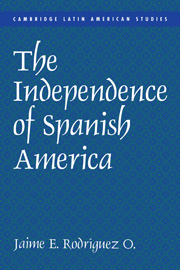3 - The Birth of Representative Government
Published online by Cambridge University Press: 05 October 2013
Summary
The collapse of the Spanish Monarchy triggered a series of events that culminated in the establishment of representative government in the Spanish world. The initial step in that process was the formation of local governing juntas in Spain and America. Although the Spanish provinces made that transition easily, the American kingdoms faced opposition from royal officials, resident peninsulares, and their New World allies. Initially, neither the Spanish nor the American juntas had a clear vision of the nature of the government they would form. Most possessed vague notions of what they meant when, as the Ayuntamiento of Mexico declared, “in the absence … [of the king], sovereignty lies represented in all the kingdom.” Nonetheless, all the juntas asserted that sovereignty had reverted to the people. In practice, this meant that the elites of the provinces of Spain and the kingdoms of America assumed the mantle of the people. Moreover, since the act was taken in the name of Fernando VII, the assumption of popular sovereignty was provisional. When the king returned, presumably, sovereignty would revert to him.
Convening a Parliament
The provincial juntas of Spain administered their localities, whereas the Junta Central attempted to function as a national government. In the monarch's absence, however, Spanish legal tradition recognized the sovereignty of the representatives of the people – the cities, the tribunals, and other major corporations. Neither the provincial juntas nor the Junta Central – composed of two representatives from each Spanish province, two from Madrid as the capital, and, eventually, nine from America – fulfilled those requirements.
- Type
- Chapter
- Information
- The Independence of Spanish America , pp. 75 - 106Publisher: Cambridge University PressPrint publication year: 1998

